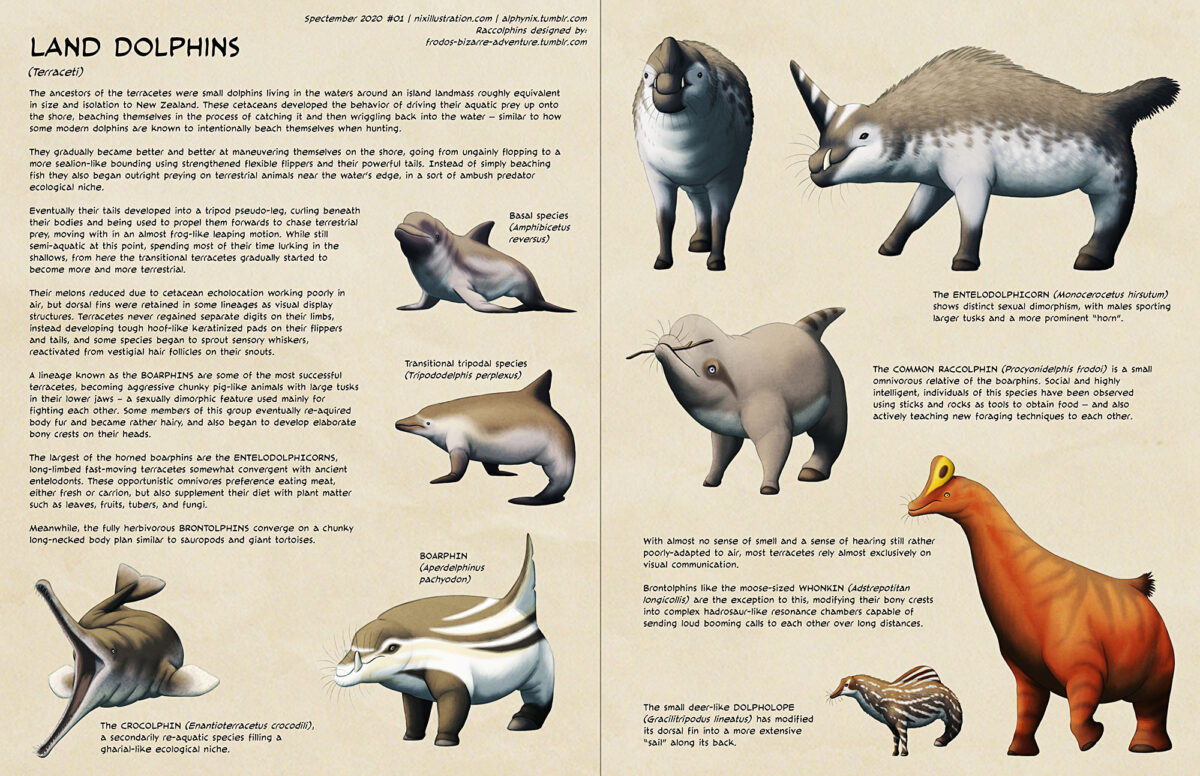Welcome to SPECTEMBER!
This month we’ll be taking a break from real creatures to instead explore some “what if” scenarios for the evolution of life.
If you’re unfamiliar with speculative evolution, it’s basically a biology-focused type of science fiction exploring hypothetical evolutionary paths, whether as alternate histories for the ancient past, possible far future descendants of modern species, or even completely alien life on other worlds. The concept has been around for well over a century at this point, but Dougal Dixon’s 1981 book After Man was probably the biggest influence.
All this month, on weekdays I’ll be posting my own work based on the suggestions from earlier in the year, and on weekends I’ll highlight some of the history of the spec evo genre.
So let’s have some fun – and if you want to join in, #spectember is an open concept and anyone is welcome to take part!
Transcript for the text on the image under the cut:
PAGE 1
Spectember 2020 #01 | nixillustration.com | alphynix.tumblr.com
Raccolphins designed by:
frodos-bizarre-adventure.tumblr.com
Land Dolphins
(Terraceti)
The ancestors of the terracetes were small dolphins living in the waters around an island landmass roughly equivalent in size and isolation to New Zealand. These cetaceans developed the behavior of driving their aquatic prey up onto the shore, beaching themselves in the process of catching it and then wriggling back into the water – similar to how some modern dolphins are known to intentionally beach themselves when hunting.
They gradually became better and better at maneuvering themselves on the shore, going from ungainly flopping to a more sealion-like bounding using strengthened flexible flippers and their powerful tails. Instead of simply beaching fish they also began outright preying on terrestrial animals near the water’s edge, in a sort of ambush predator
ecological niche.
Eventually their tails developed into a tripod pseudo-leg, curling beneath their bodies and being used to propel them forwards to chase terrestrial prey, moving with in an almost frog-like leaping motion. While still semi-aquatic at this point, spending most of their time lurking in the shallows, from here the transitional terracetes gradually started to become more and more terrestrial.
Their melons reduced due to cetacean echolocation working poorly in air, but dorsal fins were retained in some lineages as visual display structures. Terracetes never regained separate digits on their limbs, instead developing tough hoof-like keratinized pads on their flippers and tails, and some species began to sprout sensory whiskers, reactivated from vestigial hair follicles on their snouts.
A lineage known as the BOARPHINS are some of the most successful terracetes, becoming aggressive chunky pig-like animals with large tusks in their lower jaws – a sexually dimorphic feature used mainly for fighting each other. Some members of this group eventually re-aquired body fur and became rather hairy, and also began to develop elaborate bony crests on their heads.
The largest of the horned boarphins are the ENTELODOLPHICORNS, long-limbed fast-moving terracetes somewhat convergent with ancient entelodonts. These opportunistic omnivores preference eating meat, either fresh or carrion, but also supplement their diet with plant matter such as leaves, fruits, tubers, and fungi.
Meanwhile, the fully herbivorous BRONTOLPHINS converge on a chunky long-necked body plan similar to sauropods and giant tortoises.
[Image: a dolphin holding its body off the ground using its flippers.]
Basal species (Amphibicetus reversus)
[Image: a tripod dolphin, using both its flippers and its tail curled under its body as a makeshift third leg.]
Transitional tripodal species (Tripododelphis perplexus)
[Image: a more specialized tripod dolphin with striped markings, with its three limbs ending in horse-like single hooves. It has a pair of tusks sticking up from its lower jaw and bristly whiskers on its snout and face.]
BOARPHIN (Aperdelphinus pachyodon)
[Image: a vaguely crocodile-like dolphin laying on its belly, its long toothy snout open wide.]
The CROCOLPHIN (Enantioterracetus crocodili), a secondarily re-aquatic species filling a gharial-like ecological niche.
PAGE 2
[Image: a pair of somewhat pig-like hairy tripod dolphins standing on longer hoofed limbs. One has larger tusks than the other, and a large horn-like structure growing from its head.]
The ENTELODOLPHICORN (Monocerocetus hirsutum) shows distinct sexual dimorphism, with males sporting larger tusks and a more prominent “horn”.
[Image: a hoofed tripod dolphin with a compact body, a short blunt snout, and raccoon-like “mask” markings over its eyes. It’s holding a stick in its mouth.]
The COMMON RACCOLPHIN (Procyonidelphis frodoi) is a small omnivorous relative of the boarphins. Social and highly intelligent, individuals of this species have been observed using sticks and rocks as tools to obtain food – and also actively teaching new foraging techniques to each other.
[Image: a chunkily-built hoofed tripod dolphin shaped somewhat like a bulky giraffe or a tailless sauropod dinosaur, with a long neck ending in a relatively small head. It has a large bulbous bony crest on its head with a colorful eyespot marking on it.]
With almost no sense of smell and a sense of hearing still rather poorly-adapted to air, most terracetes rely almost exclusively on visual communication.
Brontolphins like the moose-sized WHONKIN (Adstrepotitan longicollis) are the exception to this, modifying their bony crests into complex hadrosaur-like resonance chambers capable of sending loud booming calls to each other over long distances.
[Image: a small hoofed tripod dolphin with striped camouflage markings and its dorsal fin forming a “sailback” structure.]
The small deer-like DOLPHOLOPE (Gracilitripodus lineatus) has modified its dorsal fin into a more extensive “sail” along its back.

